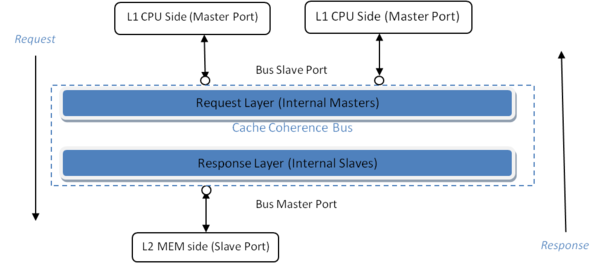Classic Memory System
Contents
MemObjects
Caches
The default cache is a non-blocking cache with MSHR (miss status holding register) and WB (Write Buffer) for read and write misses. The Cache can also be enabled with prefetch (typically in the last level of cache). The default replacement policy for the cache lines is LRU (least recently used).
Hooking them up
test
Parameters
Interconnects
Buses
The two types of traffic in the bus are memory-mapped packets and snooping packets. The memory-mapped requests go down the memory hierarchy, and responses go up the memory hierarchy (same route back). The snooping requests go horizontally and up the cache hierarchy, snooping responses go horizontally and down the hierarchy (same route back). Normal snoops go horizontally and express snoops go up the cache hierarchy. http://resumewritingservices.ws/
Bridges
Anything else?
Coherence
M5 2.0b4 introduced a substantially rewritten and streamlined cache model, including a new coherence protocol. (The old pre-2.0 cache model had been patched up to work with the new Memory System introduced in 2.0beta, but not rewritten to take advantage of the new memory system's features.)
The key feature of the new coherence protocol is that it is designed to work with more-or-less arbitrary cache hierarchies (multiple caches each on multiple levels). In contrast, the old protocol restricted sharing to a single bus.
In the real world, a system architecture will have limits on the number or configuration of caches that the protocol can be designed to accommodate. It's not practical to design a protocol that's fully realistic and yet efficient for arbitrary configurations. In order to enable our protocol to work on (nearly) arbitrary configurations, we currently sacrifice a little bit of realism and a little bit of configurability. Our intent is that this protocol is adequate for researchers studying aspects of system behavior other than coherence mechanisms. Researchers studying coherence specifically will probably want to replace the default coherence mechanism with implementations of the specific protocols under investigation.
The protocol is a MOESI snooping protocol. Inclusion is not enforced; in a CMP configuration where you have several L1s whose total capacity is a significant fraction of the capacity of the common L2 they share, inclusion can be very inefficient.
Requests from upper-level caches (those closer to the CPUs) propagate toward memory in the expected fashion: an L1 miss is broadcast on the local L1/L2 bus, where it is snooped by the other L1s on that bus and (if none respond) serviced by the L2. If the request misses in the L2, then after some delay (currently set equal to the L2 hit latency), the L2 will issue the request on its memory-side bus, where it will possibly be snooped by other L2s and then be issued to an L3 or memory.
Unfortunately, propagating snoop requests incrementally back up the hierarchy in a similar fashion is a source of myriad nearly intractable race conditions. Real systems don't typically do this anyway; in general you want a single snoop operation at the L2 bus to tell you the state of the block in the whole L1/L2 hierarchy. There are a handful of methods for this:
- just snoop the L2, but enforce inclusion so that the L2 has all the info you need about the L1s as well---an idea we've already rejected above
- keep an extra set of tags for all the L1s at the L2 so those can be snooped at the same time (see the Compaq Piranha)---reasonable, if you're hierarchy's not too deep, but now you've got to size the tags in the lower-level caches based on the number, size, and configuration of the upper-level caches, which is a configuration pain
- snoop the L1s in parallel with the L2, something that's not hard if they're all on the same die (I believe Intel started doing this with the Pentium Pro; not sure if they still do with the Core2 chips or not, or if AMD does this as well, but I suspect so)---also reasonable, but adding explicit paths for these snoops would also make for a very cumbersome configuration process
We solve this dilemma by introducing "express snoops", which are special snoop requests that get propagated up the hierarchy instantaneously and atomically (much like the atomic-mode accesses described on the Memory System page), even when the system is running in timing mode. Functionally this behaves very much like options 2 or 3 above, but because the snoops propagate along the regular bus interconnects, there's no additional configuration overhead. There is some timing inaccuracy introduced, but if we assume that there are dedicated paths in the real hardware for these snoops (or for maintaining the additional copies of the upper-level tags at the lower-level caches) then the differences are probably minor.
(More to come: how does a cache know when its request is completed? and other fascinating questions...)
Note: there are still some bugs in this protocol as of 2.0b4, particularly if you have multiple L2s each with multiple L1s behind it, but I believe it works for any configuration that worked in 2.0b3.
